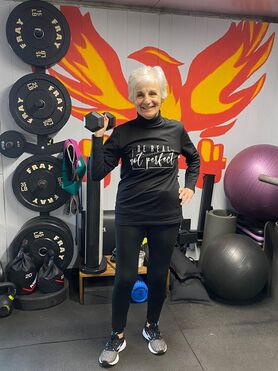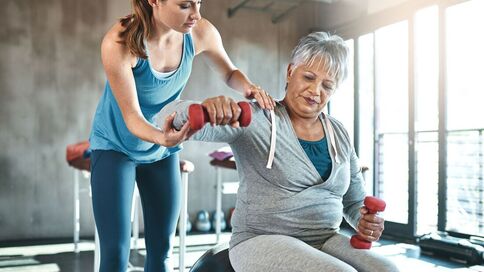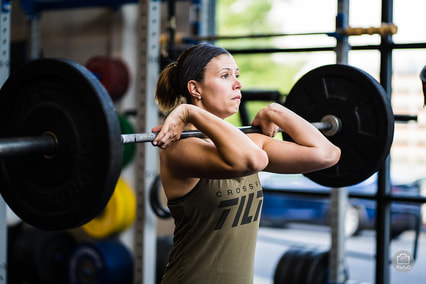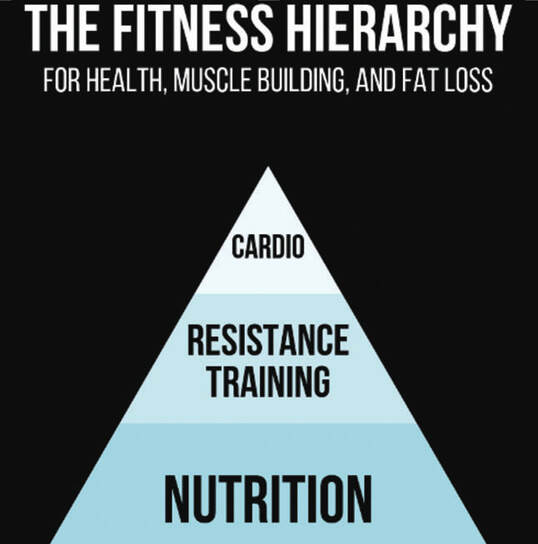|
Welcome to 2024!
As we dive into the new year, let's focus on what really matters for fat-loss. I'm not about quick fixes or fads. It's all about practical steps you can actually stick to. This is my 9th January working in fitness, and I'm often inspired and rejuvenated by the new year too. Many people bash "resolutions," making it feel vulnerable to admit having big health goals for the new year. But you aren't alone. There are plenty of others watching this who want to improve how they look, move, and feel. The number one thing I hear from people at the beginning of each new year is their desire to lose weight, closely followed by wishes to eat "better" and "exercise more." Let’s tackle two out of these three: losing weight and eating better. These are the two things (besides maybe better sleep) that will help you feel better. So here is Tip #1 of the 10 no-nonsense strategies to help you lose fat more easily this year.
Stay strong, Coach Kayli!
0 Comments
 Like it or not, a number of changes happen to our bodies as we age. They are a natural part of living life and include a combination of age-related structural, biochemical and physiological changes. Some of these changes are inevitable, however how we live our lives, including how much activity and exercise we do, has a huge influence on the speed and extent of these changes. We all know exercise is good for us and has lots of benefits to our health. Perhaps less well known are the benefits of strength training (resistance training), which are fortunately now becoming more widely researched and promoted. Perhaps even less well known are the benefits of strength training specifically for older adults. Strength training has multiple health and lifestyle benefits for older adults. So much so that in our opinion, it should be a mandatory prescription from your doctor. Let’s explore why… What happens to our bodies when we age?
All of the changes above can have huge consequences. Some are inevitable with aging, others have environmental and genetic risk factors which also play a role. The changes in our muscles and bones cause slowing down, aches and pains, making performing our normal daily activities such as walking, climbing stairs and household tasks more difficult. It also puts you at an increased risk of falling over, and of serious injury such as fractures if you do. Ultimately, older adults with low muscle mass and bone density are at a higher risk of a poor quality of life, loss of independence and even an earlier death. The levels of muscle mass and strength loss varies in different people. Generally we are at our peak maximum physical capacity between 20-30 years old. Our muscle mass then starts to gradually decline until we are about 50 years old, after which the decline starts to happen more rapidly. Studies have shown that strength loss can occur as fast as 15% per decade after our 50s. Though, the level of loss and rate of decline varies in different people because of a variety of factors including lifestyle, genetics and the presence of other conditions or diseases. Hearing all of this can sound very scary. It can make the changes happening to our bodies in aging seem beyond our control. But that’s far from the truth. The power of strength training Not all of the changes listed above are inevitable with aging. There is evidence to show that a large amount of the decline in muscle strength seen in aging is due to inactivity and disuse. A number of other studies now show that these changes can actually be reversed too. We can slow these changes down, we can reduce the loss of muscle and bone density and even improve it as we age. We therefore can take ownership and control of our bodies in aging. Unfortunately, there is no magic medication, but there is something you can do in exercise and, more specifically, strength training. It just involves a little more effort than taking a pill every morning. That being said, strength training can also actually be more enjoyable and has many more benefits than just improving your muscle mass or bone density. What are the benefits of strength training for older adults?There is very clear evidence for the benefits of strength training in older adults to improve muscle strength, mass and functioning, as well as increase bone density. Strength training induces muscle growth, improves muscle mass and increases muscle strength. It makes your muscles stronger, more powerful and keeps them doing their very important job in allowing you to do all the functional things you want to do in your life. Whether that be walking around pain free to go to the shops and see friends, looking after your children and grandchildren, going on long bike rides and country walks, playing sports or even running marathons. There is a growing body of evidence demonstrating the significant benefits of strength training for all age groups (improved muscle and bone health, improved body composition and fat loss, prevention of a huge number of chronic and preventable diseases, improved energy levels and mood). These benefits are increasingly important as we age. Performed regularly, 2 or 3 times a week, strength training specifically in older adults has been shown to:
The list goes on and on… so the real question is, when are you going to get started? Starting strength training as an older adult can sound like a scary prospect, but it doesn’t have to be. You don’t need to do it at the gym with heavy weights (though you absolutely can do), it can be something carried out in your home with little or no equipment. Browse our website to learn more, or get in touch for personalized 1:1 coaching. - Coach Kayli “I just want to be toned,” “I lost the weight, but I don’t have the body I want,” “I want to look like I lift . . “
Any of those sound familiar? This is what I hear from most people that come to Kayli and I for coaching. Most people just aren’t happy with the shape of their body. Some have lost weight but still don’t like the shape of their body. Some state they would be happy if they just looked “toned.” If you’ve been following Kayli and I, you know we shudder when we hear the word toned. Toned was a made up word by marketing people to sell fitness and lifting to women. When you say you want to be “toned” what you really mean is you want to gain visible muscle definition. This can mean either building muscle or losing body fat to expose your muscle tissue. This can stop some people, particularly women, in their tracks. Many women become afraid of lifting weights and gaining muscle because they don’t want to “get too big,” “look like a man,” or “get bulky.” What they don’t realize is that because of their hormonal makeup, it is virtually impossible for them to do any of those things. Men have much more testosterone than women. Testosterone is the primary muscle building hormone. While women have some testosterone, we do not have the amount necessary to get as muscular as men. So now that we have put the worries to bed and I have you super stoked to start growing muscle . . . let’s look at the 10 laws necessary for muscle growth.
Alright friends . . . you are now armed with the laws of muscle building. Go forth and grow!  First, what is Osteoporosis? Osteoporosis is a condition characterized by weak and fragile bones that are liable to fracture. Normal, strong and healthy bones contain large amounts of minerals, which make them strong. The amount of these bone minerals within our bones is referred to as our bone mineral density (BMD). Our bones are in a constant state of adaptation, with bone being broken down and remodeled and rebuilt continuously. When bones break down faster than they rebuild, our bone mineral density decreases. Our BMD is highest when we are aged in our 20s, and then as we get older our BMD gradually declines. If this loss of minerals from the bone is excessive, our BMD will become very low, and we will develop osteoporosis. Osteoporosis is a common cause of fractures in older Americans, especially women. In women, the greatest rate of bone loss occurs in the years immediately following menopause. How can resistance training help? Resistance training to prevent osteoporosis: Regular weight-bearing exercise in children and teenagers helps produce strong bones; in adults it helps to maintain bone mass; after menopause it can be part of an overall treatment plan that aims to slow the rate of bone loss; and in adults over 65 years physical activity can be used to both reduce the rate of bone loss and avoid injury to bones by improving muscle strength and balance. The strength of your bones also determines the type of exercise that is appropriate and safe for your bones. Certain types of resistance training have been shown to minimize the loss in BMD, and in some research studies to even produce an increase in BMD. This is beneficial for both the prevention and the treatment of osteoporosis. If you already have osteoporosis or other medical conditions and have not exercised regularly, speak to a professional about designing an exercise program that is suitable for you. The best types of exercise for decreasing the risk of developing osteoporosis are:
Exercises such as swimming and cycling help improve cardiovascular fitness and build muscle strength, but are not as effective at preventing osteoporosis as weight-bearing exercise. So if you are already swimming or cycling regularly but not doing any other forms of exercise, you should consider adding weight-bearing and/or resistance exercise to your weekly routine. Always check with your doctor before starting a new exercise program. Resistance training helps improve your bone health by putting strain on the bones, which helps make them stronger. As your body adapts you will need to increase the resistance to continue to improve bone strength. There is some evidence indicating that progressing to heavier resistances is most effective in preventing the loss of an increasing BMD. Doing a program of resistance exercises 2-3 times per week has been shown to help maintain and even increase bone mineral density in women who have gone through menopause. Resistance training also helps to build up and maintain muscle mass, which helps reduce the risk of falls. Resistance Training For All Since the prevention of osteoporosis is a far better strategy than trying to reverse it, all adults should undertake regular weight-bearing and/or resistance training regardless of their age. In young people this will help to increase their BMD to higher peak levels, which will then reduce the risk of it declining to osteoporotic levels later in life. Continuing with this exercise throughout your life will minimize the decline in BMD that occurs with age and further reduce the risk of osteoporosis in old age. Want help? Not sure where to start or what program to run? That’s where I come in! Let me help you get started in your fitness journey with a safe, effective resistance training program tailored to your body and your goals. If having someone in your corner every step of the way in training, nutrition and mindset sounds like something you would greatly benefit from then take 2 minutes and click the link below to fill out an application for a 15 minute coaching call with me. Where we will discuss your goals in great detail and find out if we would make a great fit to work together.  Studies have shown that resistance training has many positive effects on physical health, but did you know that resistance training is also a good tool to use for mental health as well? Studies have shown that resistance training has had positive benefits on many mental health issues. Of the trials conducted, participants have seen reductions in anxiety symptoms, reduction in pain intensity among patients with lower back pain, osteoarthritis and fibromyalgia, improvements in cognition among older adults, improvements in sleep quality among depressed older adults, reductions in symptoms of depression among patients with diagnosed depression and fibromyalgia, reductions in fatigue symptoms, and improvements in self esteem. Many of these things all seem connected. For example, weight training helps a patient sleep better which is going to lower ghrelin (the body’s hunger hormone). In turn, potentially causing them to reduce unnecessary snacking to help them lose a few pounds which could cause an improvement in self esteem. All of these things are interconnected in various different ways. Aside from all the mental health positives, resistance training also seems to have some built factors that help your overall approach to life a bit differently. Other than peace of mind and some self confidence, resistance training seems to also act as a wise janitor of life coming to teach you valuable life lessons and skills. The first, stronger muscles make daily tasks easier. If your everyday tasks can be performed with less pain and more ease, the stress of completing them will drop. Plus, the confidence boost of feeling stronger and being more self reliant isn’t a bad side effect either. Unless of course you are a husband that takes pride in opening the pickle jar! Second, let go with care. Hear me out! So when you lift weights, it’s important to perform both the eccentric and concentric motions with care and purpose in order to get the most out of the movement. It is simply key to proper performance. You should always use as much care to put down the weight as you did to pick it up. In life, when we are exhausted or overwhelmed by something, we often just cast it aside thoughtlessly and be done with it. Just give up. This will rarely serve you well. Ah, yes, next up, the value of rest. When I design programs, I assign specific rest periods between sets. There is a reason for this. You need to give your central nervous system a break and allow it to regroup before jumping right back into a lift. This is often why rest periods are longer on programs with heavy compound lifts. They are more taxing to your CNS than lower weight accessory movements. So, how does this relate to life you ask . . . well, just like weight training, when you pause in other areas of your life instead of rushing through tasks as quickly as possible, you’ll find that you are more productive and more positive results will emerge. Often you just need to find the right balance between rest and work. This one is another favorite of mine! The power of breath! Yes, breath. I know breathing is essential to life, but that’s not where I’m going with that. Those of you that have trained with me in person have probably heard me instruct you on how to breathe when you are lifting weights. It is very important for effective weight lifting to breathe properly. Generally speaking, you should be inhaling during the concentric and exhaling during the eccentric. This allows you to get maximal force in your lift. Similar effects can be seen during trying times in life. When you are feeling pressure or anxious, take a deep breath. Taking a few deep breaths will help you speak up, calm down and keep your cool much easier. Last but not least, to build strong muscles, you must break them. Yep, that’s right. When you lift weights, you tear your muscles. That’s the point, because they come back bigger and stronger. (insert Hulk growl) Think about it. You experience muscle growth after you tear the muscles. So basically to make a muscle stronger you have to injure it. It’s through the process of repair it gets stronger. Think about the hardest moments in your life. Think about how much they hurt. Did you get through it? Are you stronger now because of it? I would bet that every challenge you’ve encountered in your life has made you stronger and that’s because with pain comes growth. That growth can be emotional too. After all the heart is a muscle too. If I haven’t already spoken enough about the benefits of weight training, here’s just some more science backed evidence to show that resistance training literally can benefit everyone, in some way. You don’t have to be a bodybuilder or a powerlifter that’s training for a show to see benefits. Everyone has something to gain. If you’re ready to make a change in your life, but don’t know where to start, apply for a free coaching call. I’d love to be a part of your journey to a better life.  I want to teach you where you should put the majority of your focus on if you're wanting to lose fat, build some muscle and just care about your overall health. This Hierarchy was explained very well to me by my Coach Jeremiah Bair. I would love to share with you what I have learned from him. To the right, you will see The Fitness Hierarchy Ranked from most-least important:
Most people are surprised by this, expecting cardio to be the number one focus, followed by stepping into the gym a few times, and dieting hard for a couple weeks every January. Now why doesn’t this work? Nutrition In order to lose fat we must eat fewer calories than we burn in a day. It is impossible to erase a poor diet with exercise. Why? Because you just don’t burn very many calories when you exercise (about 5% of your total daily calorie burn comes from exercise.) Calories in < Calories out = Fat Loss. This is called Energy Balance Main takeaway here is watching your diet to control the “calories in” side of the energy balance equation is much easier than trying to lose fat by ramping up the “calories out” side of the equation. This is why Nutrition is the most important factor to pay attention to. Resistance Training Lifting weights actually burns fewer calories than cardio. But, resistance training has many more benefits for you than cardio:
It’s rewarding It’s a huge psychological boost Find a plan you can see yourself sticking to for a really long time. Cardio Cardio is still helpful. We just don’t want to put the majority of our focus in it. Cardio has obvious cardiovascular health benefits-it’s good for your heart. Cardio has carryover to your resistance training. It allows you to recover quicker - both between sets and between training sessions. Now the biggest issue with cardio is that your body adapts very quickly to it. When you adapt to something, you become more efficient at it. Becoming efficient means you’re burning less calories. So take this for example: If you were to run 1 mile you might burn 100 calories. As the adaptation occurs, the calorie burn decreases. So after running a mile every day this week and burning a 100 calories each time you may end up only burning 90 calories the next week, and then 80 the next. The only way to keep burning 100 calories is to increase the distance and/or time spent running. The problem is - who has the time or desire in our busy lives to keep adding miles forever? Conclusion:
-Coach Kayli Questions? Email me: [email protected] |
AuthorKayli is a certified personal trainer and online coach that specializes in fitness, wellness, nutrition, mindset, mobility and everything in between. Categories
All
Archives
June 2024
|
Call Us 620-757-9146
Home | About Us | Personal Training | Online Nutrition and Fitness Coaching | Custom Training Plans | Breakfast | Entrees | Dressings | Snacks | Blog
Phoenix Rising Podcast | Product Recommendations | Contact Me
Phoenix Rising Podcast | Product Recommendations | Contact Me
Copyright 2024 Kayli Montoya Fitness

